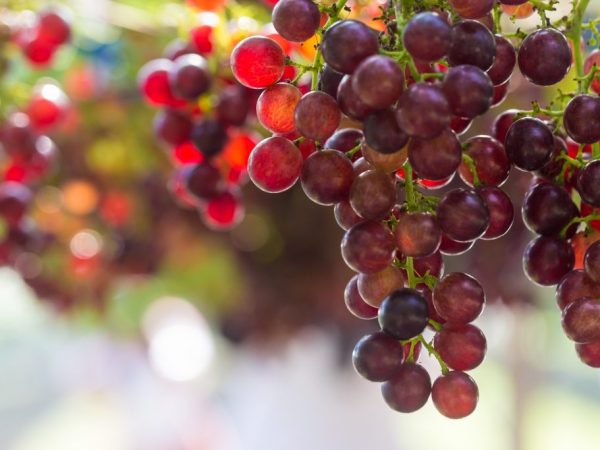Grapes Count of Monte Cristo
The Count of Monte Cristo grape is an artificially bred table variety by crossing the Talisman and Rizamata varieties. Saplings have been on the market since the 2000s. The author of the variety is the breeder Kapelyushny.

Grapes Count of Monte Cristo
Characteristics of the variety
According to the description, the Count of Monte Cristo is a medium-ripening grape. Ripens in about 130-135 days. There is no peeling. The flowers are bisexual, the presence of other varieties for pollination is not necessary. The bush is frost-resistant, withstands temperatures down to -25 ° C. The first crop is harvested after 2 years, if you use own-rooted seedlings when planting.
Count of Monte Cristo practically does not cause allergic reactions. It is recommended to be consumed during a diet. The resulting juice does not need the addition of sugar; it is used in cooking, for salads, meat and fish dishes. Suitable as a substitute for lemon juice.
Description of the bush
Monte Cristo is characterized by large, vigorous shrubs. Shoots are also large, fast-growing. Large brushes, cone-shaped, medium density. The weight of one bunch is from 800 g, and with proper care and watering it reaches 1.5 kg. One bush contains 30-35 eyes. The cuttings root freely. Pruning is carried out for 6-8 eyes, but a good harvest is possible with a short pruning of 4-6 eyes.
Description of berries
According to the description of the variety, the berries are large, oval in shape, of the same size, medium density, weighing 25-30 g, red-burgundy, evenly distributed over the bunch. When fully ripe, they turn dark pink and are covered with a matte bloom. The size of the fruit is 3 cm wide and 3.6-4 cm long. The skin is soft, it can be separated freely. The amount of sugar in the fruit is 19%, the figure varies depending on the climate and the quality of plant care.
Harvesting can not be carried out immediately, the grapes retain their taste for a long time and do not lose their appearance.
Growing varieties
Planting is carried out both in spring and autumn. In early spring, lignified seedlings are planted, and from May to June, green, vegetative ones. Seedlings are usually sold in the fall, it makes sense to plant at this time of the year, because the plant will dry out before spring.
When planting in black soil, the pit should be 80 cm deep, and if the soil is sandy, then at least 1 m. Deep planting protects the roots from hypothermia. The first layer is filled with crushed stone 10-15 cm and a plastic pipe of medium diameter is installed at a distance of 10 cm from the edge. After that, there is a layer of black soil of the same thickness, which is mixed with 150 g of potash fertilizer and 200 g of superphosphate, or they are replaced with 3 liters. ash. These 2 layers are repeated, soil is poured on top and tamped to remove excess air. For irrigation, use 5-6 buckets of water.
Care

Avoid over-watering
It is necessary to ensure regular watering. Usually 2-3 buckets are enough, but on dry days the amount is increased to 4-5 per bush. With an excess of moisture, fruits crack due to their large size, therefore, excessive watering is contraindicated.When it rains, you should also limit the amount of water entering the soil.
Carry out mulching, this will help the soil to retain moisture and the plant will not dry out in the absence of watering for a long time. Among other things, it also inhibits the growth of weeds. To enrich the soil with oxygen, it is periodically loosened.
For the winter, the plant is covered with pine branches to prevent freezing. The mulch is not removed; it helps to retain heat. It is allowed to additionally add nitrogenous fertilizers to the soil; in winter, their use is justified.
Diseases of the variety
According to the description, Graf Monte Cristo is more resistant to mildew and powdery mildew than other varieties, but cracking of the berries due to their large size is a common problem. A fungal infection often gets into the formed cracks. Therefore, any cracked or infected fruit is removed immediately.
- Oidium or powdery mildew is a fungal disease that affects shoots and leaves, and it can also infect inflorescences, limiting their growth and inhibiting ripening. It looks like a white bloom on young shoots; in summer, a mealy bloom appears on the front and back of the leaves. To fight, sulfur is used, which destroys mycelium. When spraying, the solution should reach all areas without leaving untreated areas.
- Mildew or downy mildew is the most dangerous disease and is difficult to treat. The plant produces less yield and becomes more vulnerable to cold weather. The causative agent is a fungus that parasitizes the leaves. Spores are resistant to weather factors, easily endure winter. Infection begins in spring, the incubation period is 3-15 days. The symptom is powdery spots on the leaves that grow over time and cause the leaves to fall off.
Conclusion
The Count of Monte Cristo is ideal for both homemade preparations and fresh consumption. Bunches of these grapes will be a wonderful decoration for any table.


